Examining the Ethics of Teaching Sexuality Education in Schools
VerifiedAdded on 2023/04/22
|8
|2234
|429
Essay
AI Summary
This essay explores the ethical dimensions of teaching sexuality education in primary schools, addressing the ongoing debate about its inclusion in the curriculum. It discusses various approaches to sexuality education, including the whole-school approach, abstinence-only approach, and comprehensive sex education, evaluating their impact on students and teachers. The essay highlights the potential benefits of sexuality education, such as increased knowledge of sexual health, dispelling myths, and protecting children from sexual abuse. It also acknowledges concerns raised by parents and care providers. Ultimately, the essay concludes that sexuality education is a prerequisite for a healthier future generation, emphasizing the importance of a collaborative effort between parents, teachers, and schools to provide children with proper knowledge about sexuality.
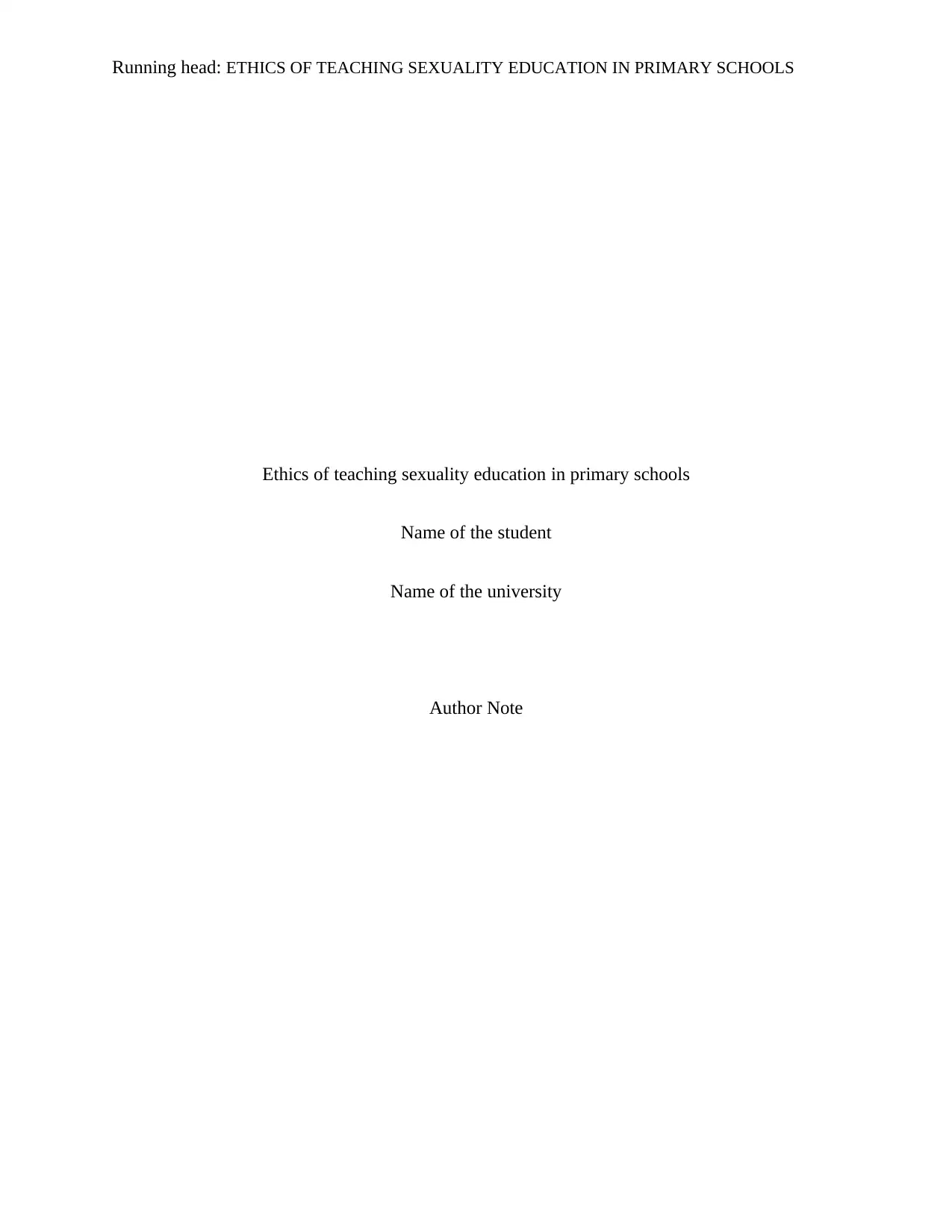
Running head: ETHICS OF TEACHING SEXUALITY EDUCATION IN PRIMARY SCHOOLS
Ethics of teaching sexuality education in primary schools
Name of the student
Name of the university
Author Note
Ethics of teaching sexuality education in primary schools
Name of the student
Name of the university
Author Note
Paraphrase This Document
Need a fresh take? Get an instant paraphrase of this document with our AI Paraphraser
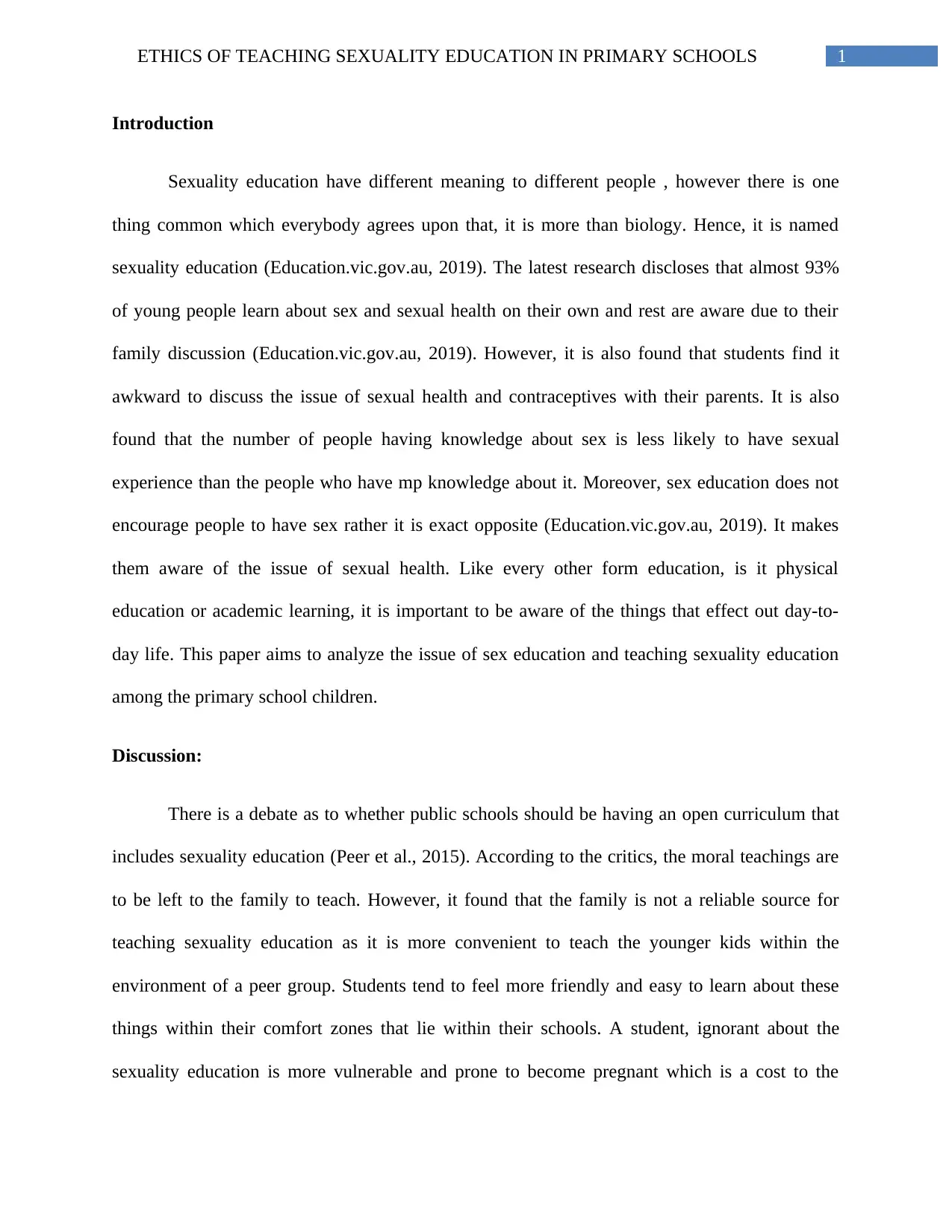
1ETHICS OF TEACHING SEXUALITY EDUCATION IN PRIMARY SCHOOLS
Introduction
Sexuality education have different meaning to different people , however there is one
thing common which everybody agrees upon that, it is more than biology. Hence, it is named
sexuality education (Education.vic.gov.au, 2019). The latest research discloses that almost 93%
of young people learn about sex and sexual health on their own and rest are aware due to their
family discussion (Education.vic.gov.au, 2019). However, it is also found that students find it
awkward to discuss the issue of sexual health and contraceptives with their parents. It is also
found that the number of people having knowledge about sex is less likely to have sexual
experience than the people who have mp knowledge about it. Moreover, sex education does not
encourage people to have sex rather it is exact opposite (Education.vic.gov.au, 2019). It makes
them aware of the issue of sexual health. Like every other form education, is it physical
education or academic learning, it is important to be aware of the things that effect out day-to-
day life. This paper aims to analyze the issue of sex education and teaching sexuality education
among the primary school children.
Discussion:
There is a debate as to whether public schools should be having an open curriculum that
includes sexuality education (Peer et al., 2015). According to the critics, the moral teachings are
to be left to the family to teach. However, it found that the family is not a reliable source for
teaching sexuality education as it is more convenient to teach the younger kids within the
environment of a peer group. Students tend to feel more friendly and easy to learn about these
things within their comfort zones that lie within their schools. A student, ignorant about the
sexuality education is more vulnerable and prone to become pregnant which is a cost to the
Introduction
Sexuality education have different meaning to different people , however there is one
thing common which everybody agrees upon that, it is more than biology. Hence, it is named
sexuality education (Education.vic.gov.au, 2019). The latest research discloses that almost 93%
of young people learn about sex and sexual health on their own and rest are aware due to their
family discussion (Education.vic.gov.au, 2019). However, it is also found that students find it
awkward to discuss the issue of sexual health and contraceptives with their parents. It is also
found that the number of people having knowledge about sex is less likely to have sexual
experience than the people who have mp knowledge about it. Moreover, sex education does not
encourage people to have sex rather it is exact opposite (Education.vic.gov.au, 2019). It makes
them aware of the issue of sexual health. Like every other form education, is it physical
education or academic learning, it is important to be aware of the things that effect out day-to-
day life. This paper aims to analyze the issue of sex education and teaching sexuality education
among the primary school children.
Discussion:
There is a debate as to whether public schools should be having an open curriculum that
includes sexuality education (Peer et al., 2015). According to the critics, the moral teachings are
to be left to the family to teach. However, it found that the family is not a reliable source for
teaching sexuality education as it is more convenient to teach the younger kids within the
environment of a peer group. Students tend to feel more friendly and easy to learn about these
things within their comfort zones that lie within their schools. A student, ignorant about the
sexuality education is more vulnerable and prone to become pregnant which is a cost to the
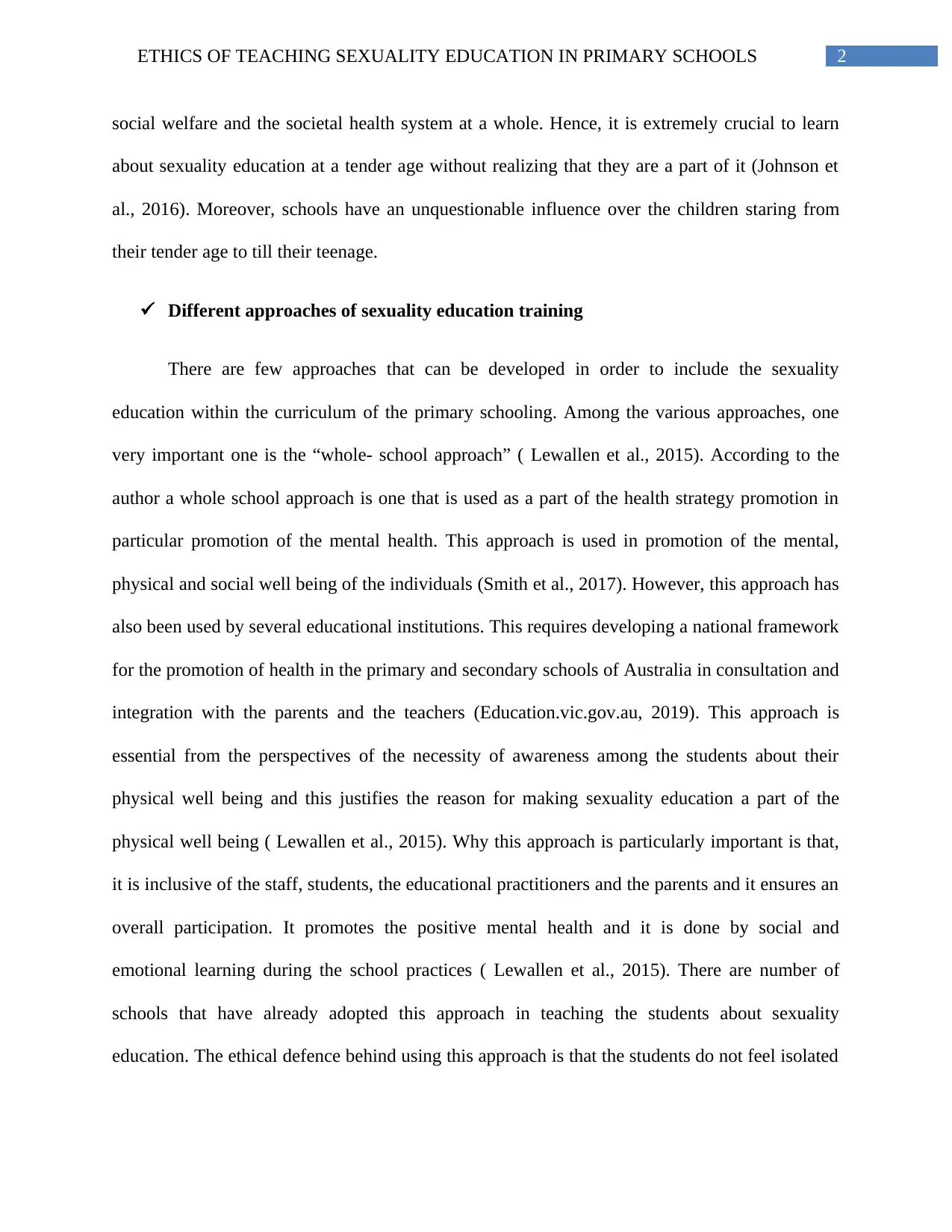
2ETHICS OF TEACHING SEXUALITY EDUCATION IN PRIMARY SCHOOLS
social welfare and the societal health system at a whole. Hence, it is extremely crucial to learn
about sexuality education at a tender age without realizing that they are a part of it (Johnson et
al., 2016). Moreover, schools have an unquestionable influence over the children staring from
their tender age to till their teenage.
Different approaches of sexuality education training
There are few approaches that can be developed in order to include the sexuality
education within the curriculum of the primary schooling. Among the various approaches, one
very important one is the “whole- school approach” ( Lewallen et al., 2015). According to the
author a whole school approach is one that is used as a part of the health strategy promotion in
particular promotion of the mental health. This approach is used in promotion of the mental,
physical and social well being of the individuals (Smith et al., 2017). However, this approach has
also been used by several educational institutions. This requires developing a national framework
for the promotion of health in the primary and secondary schools of Australia in consultation and
integration with the parents and the teachers (Education.vic.gov.au, 2019). This approach is
essential from the perspectives of the necessity of awareness among the students about their
physical well being and this justifies the reason for making sexuality education a part of the
physical well being ( Lewallen et al., 2015). Why this approach is particularly important is that,
it is inclusive of the staff, students, the educational practitioners and the parents and it ensures an
overall participation. It promotes the positive mental health and it is done by social and
emotional learning during the school practices ( Lewallen et al., 2015). There are number of
schools that have already adopted this approach in teaching the students about sexuality
education. The ethical defence behind using this approach is that the students do not feel isolated
social welfare and the societal health system at a whole. Hence, it is extremely crucial to learn
about sexuality education at a tender age without realizing that they are a part of it (Johnson et
al., 2016). Moreover, schools have an unquestionable influence over the children staring from
their tender age to till their teenage.
Different approaches of sexuality education training
There are few approaches that can be developed in order to include the sexuality
education within the curriculum of the primary schooling. Among the various approaches, one
very important one is the “whole- school approach” ( Lewallen et al., 2015). According to the
author a whole school approach is one that is used as a part of the health strategy promotion in
particular promotion of the mental health. This approach is used in promotion of the mental,
physical and social well being of the individuals (Smith et al., 2017). However, this approach has
also been used by several educational institutions. This requires developing a national framework
for the promotion of health in the primary and secondary schools of Australia in consultation and
integration with the parents and the teachers (Education.vic.gov.au, 2019). This approach is
essential from the perspectives of the necessity of awareness among the students about their
physical well being and this justifies the reason for making sexuality education a part of the
physical well being ( Lewallen et al., 2015). Why this approach is particularly important is that,
it is inclusive of the staff, students, the educational practitioners and the parents and it ensures an
overall participation. It promotes the positive mental health and it is done by social and
emotional learning during the school practices ( Lewallen et al., 2015). There are number of
schools that have already adopted this approach in teaching the students about sexuality
education. The ethical defence behind using this approach is that the students do not feel isolated
⊘ This is a preview!⊘
Do you want full access?
Subscribe today to unlock all pages.

Trusted by 1+ million students worldwide
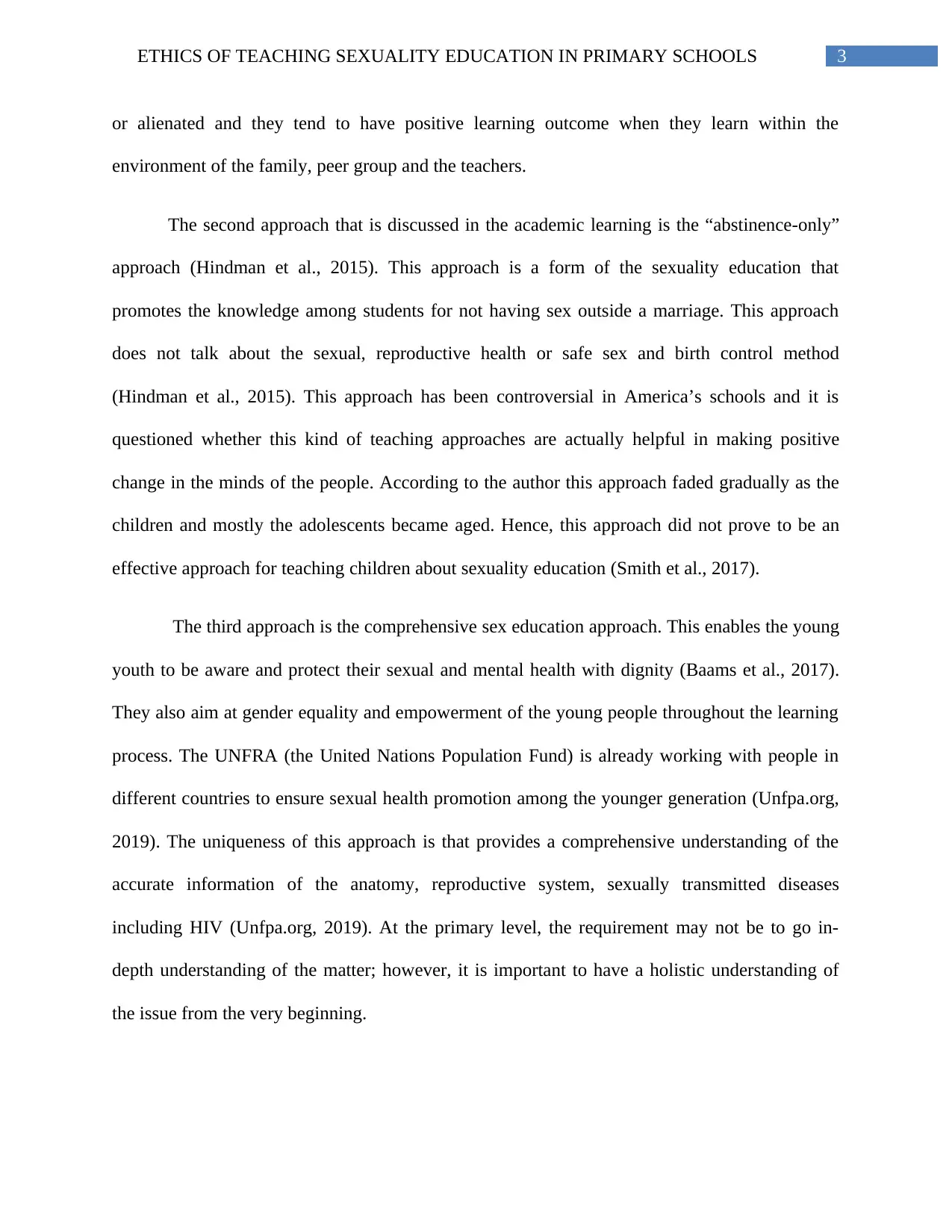
3ETHICS OF TEACHING SEXUALITY EDUCATION IN PRIMARY SCHOOLS
or alienated and they tend to have positive learning outcome when they learn within the
environment of the family, peer group and the teachers.
The second approach that is discussed in the academic learning is the “abstinence-only”
approach (Hindman et al., 2015). This approach is a form of the sexuality education that
promotes the knowledge among students for not having sex outside a marriage. This approach
does not talk about the sexual, reproductive health or safe sex and birth control method
(Hindman et al., 2015). This approach has been controversial in America’s schools and it is
questioned whether this kind of teaching approaches are actually helpful in making positive
change in the minds of the people. According to the author this approach faded gradually as the
children and mostly the adolescents became aged. Hence, this approach did not prove to be an
effective approach for teaching children about sexuality education (Smith et al., 2017).
The third approach is the comprehensive sex education approach. This enables the young
youth to be aware and protect their sexual and mental health with dignity (Baams et al., 2017).
They also aim at gender equality and empowerment of the young people throughout the learning
process. The UNFRA (the United Nations Population Fund) is already working with people in
different countries to ensure sexual health promotion among the younger generation (Unfpa.org,
2019). The uniqueness of this approach is that provides a comprehensive understanding of the
accurate information of the anatomy, reproductive system, sexually transmitted diseases
including HIV (Unfpa.org, 2019). At the primary level, the requirement may not be to go in-
depth understanding of the matter; however, it is important to have a holistic understanding of
the issue from the very beginning.
or alienated and they tend to have positive learning outcome when they learn within the
environment of the family, peer group and the teachers.
The second approach that is discussed in the academic learning is the “abstinence-only”
approach (Hindman et al., 2015). This approach is a form of the sexuality education that
promotes the knowledge among students for not having sex outside a marriage. This approach
does not talk about the sexual, reproductive health or safe sex and birth control method
(Hindman et al., 2015). This approach has been controversial in America’s schools and it is
questioned whether this kind of teaching approaches are actually helpful in making positive
change in the minds of the people. According to the author this approach faded gradually as the
children and mostly the adolescents became aged. Hence, this approach did not prove to be an
effective approach for teaching children about sexuality education (Smith et al., 2017).
The third approach is the comprehensive sex education approach. This enables the young
youth to be aware and protect their sexual and mental health with dignity (Baams et al., 2017).
They also aim at gender equality and empowerment of the young people throughout the learning
process. The UNFRA (the United Nations Population Fund) is already working with people in
different countries to ensure sexual health promotion among the younger generation (Unfpa.org,
2019). The uniqueness of this approach is that provides a comprehensive understanding of the
accurate information of the anatomy, reproductive system, sexually transmitted diseases
including HIV (Unfpa.org, 2019). At the primary level, the requirement may not be to go in-
depth understanding of the matter; however, it is important to have a holistic understanding of
the issue from the very beginning.
Paraphrase This Document
Need a fresh take? Get an instant paraphrase of this document with our AI Paraphraser
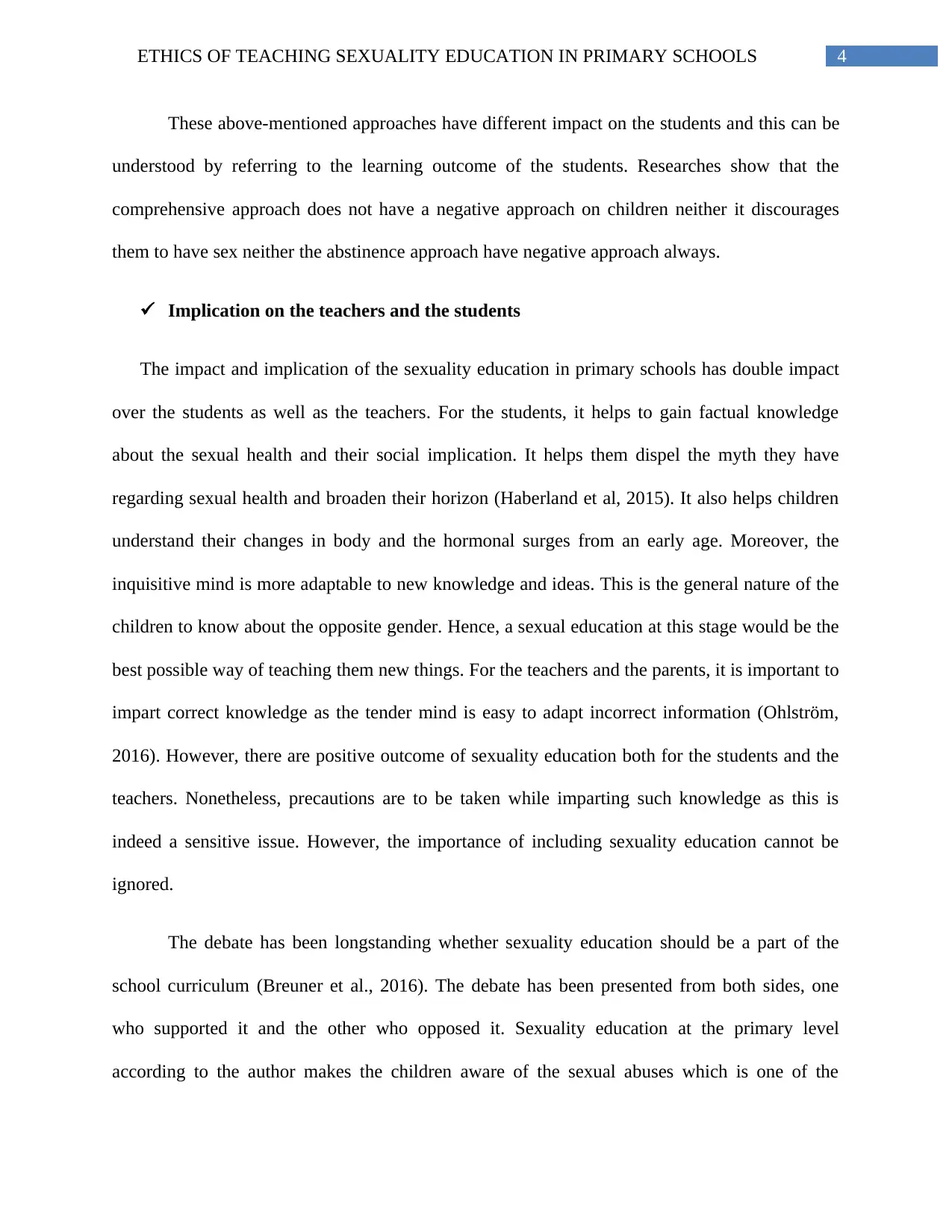
4ETHICS OF TEACHING SEXUALITY EDUCATION IN PRIMARY SCHOOLS
These above-mentioned approaches have different impact on the students and this can be
understood by referring to the learning outcome of the students. Researches show that the
comprehensive approach does not have a negative approach on children neither it discourages
them to have sex neither the abstinence approach have negative approach always.
Implication on the teachers and the students
The impact and implication of the sexuality education in primary schools has double impact
over the students as well as the teachers. For the students, it helps to gain factual knowledge
about the sexual health and their social implication. It helps them dispel the myth they have
regarding sexual health and broaden their horizon (Haberland et al, 2015). It also helps children
understand their changes in body and the hormonal surges from an early age. Moreover, the
inquisitive mind is more adaptable to new knowledge and ideas. This is the general nature of the
children to know about the opposite gender. Hence, a sexual education at this stage would be the
best possible way of teaching them new things. For the teachers and the parents, it is important to
impart correct knowledge as the tender mind is easy to adapt incorrect information (Ohlström,
2016). However, there are positive outcome of sexuality education both for the students and the
teachers. Nonetheless, precautions are to be taken while imparting such knowledge as this is
indeed a sensitive issue. However, the importance of including sexuality education cannot be
ignored.
The debate has been longstanding whether sexuality education should be a part of the
school curriculum (Breuner et al., 2016). The debate has been presented from both sides, one
who supported it and the other who opposed it. Sexuality education at the primary level
according to the author makes the children aware of the sexual abuses which is one of the
These above-mentioned approaches have different impact on the students and this can be
understood by referring to the learning outcome of the students. Researches show that the
comprehensive approach does not have a negative approach on children neither it discourages
them to have sex neither the abstinence approach have negative approach always.
Implication on the teachers and the students
The impact and implication of the sexuality education in primary schools has double impact
over the students as well as the teachers. For the students, it helps to gain factual knowledge
about the sexual health and their social implication. It helps them dispel the myth they have
regarding sexual health and broaden their horizon (Haberland et al, 2015). It also helps children
understand their changes in body and the hormonal surges from an early age. Moreover, the
inquisitive mind is more adaptable to new knowledge and ideas. This is the general nature of the
children to know about the opposite gender. Hence, a sexual education at this stage would be the
best possible way of teaching them new things. For the teachers and the parents, it is important to
impart correct knowledge as the tender mind is easy to adapt incorrect information (Ohlström,
2016). However, there are positive outcome of sexuality education both for the students and the
teachers. Nonetheless, precautions are to be taken while imparting such knowledge as this is
indeed a sensitive issue. However, the importance of including sexuality education cannot be
ignored.
The debate has been longstanding whether sexuality education should be a part of the
school curriculum (Breuner et al., 2016). The debate has been presented from both sides, one
who supported it and the other who opposed it. Sexuality education at the primary level
according to the author makes the children aware of the sexual abuses which is one of the
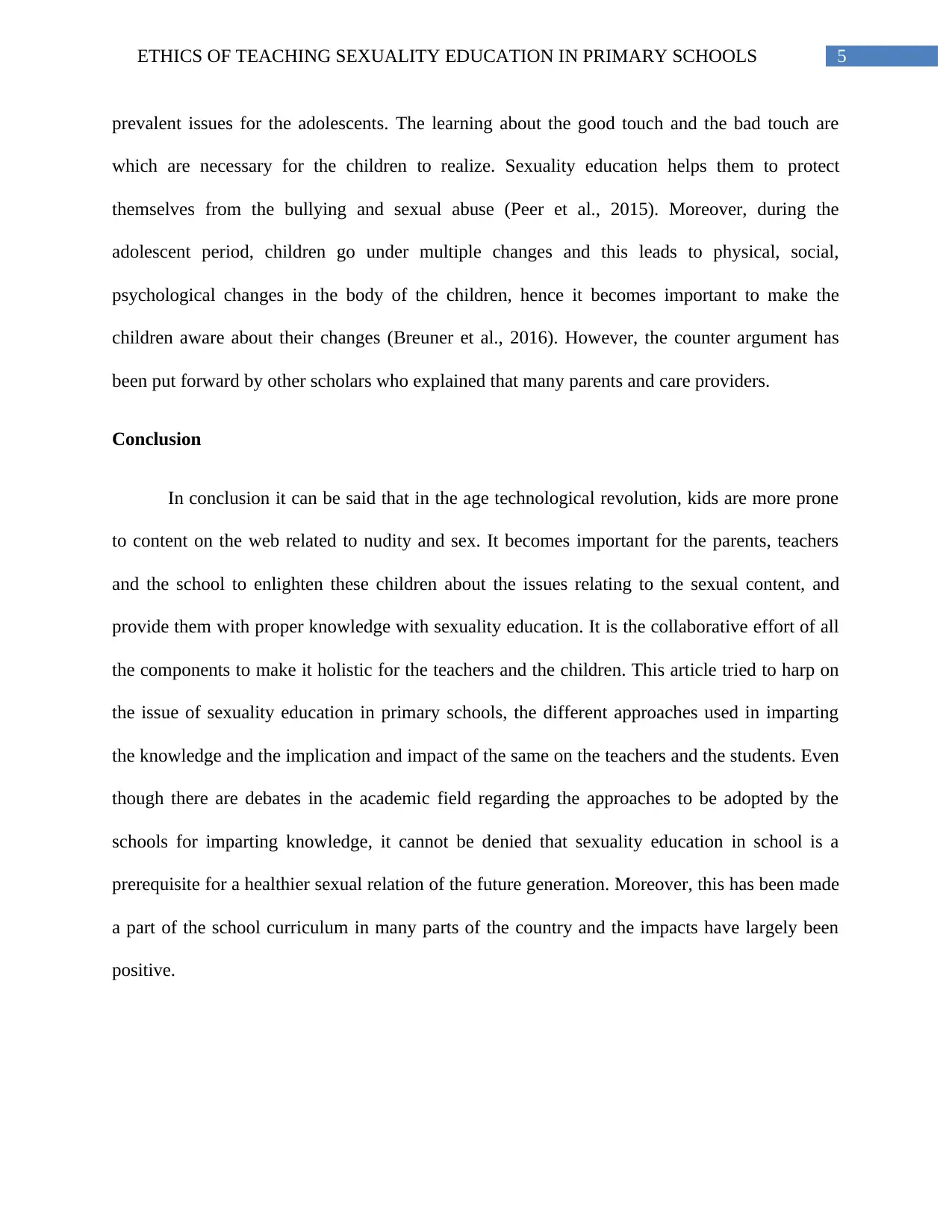
5ETHICS OF TEACHING SEXUALITY EDUCATION IN PRIMARY SCHOOLS
prevalent issues for the adolescents. The learning about the good touch and the bad touch are
which are necessary for the children to realize. Sexuality education helps them to protect
themselves from the bullying and sexual abuse (Peer et al., 2015). Moreover, during the
adolescent period, children go under multiple changes and this leads to physical, social,
psychological changes in the body of the children, hence it becomes important to make the
children aware about their changes (Breuner et al., 2016). However, the counter argument has
been put forward by other scholars who explained that many parents and care providers.
Conclusion
In conclusion it can be said that in the age technological revolution, kids are more prone
to content on the web related to nudity and sex. It becomes important for the parents, teachers
and the school to enlighten these children about the issues relating to the sexual content, and
provide them with proper knowledge with sexuality education. It is the collaborative effort of all
the components to make it holistic for the teachers and the children. This article tried to harp on
the issue of sexuality education in primary schools, the different approaches used in imparting
the knowledge and the implication and impact of the same on the teachers and the students. Even
though there are debates in the academic field regarding the approaches to be adopted by the
schools for imparting knowledge, it cannot be denied that sexuality education in school is a
prerequisite for a healthier sexual relation of the future generation. Moreover, this has been made
a part of the school curriculum in many parts of the country and the impacts have largely been
positive.
prevalent issues for the adolescents. The learning about the good touch and the bad touch are
which are necessary for the children to realize. Sexuality education helps them to protect
themselves from the bullying and sexual abuse (Peer et al., 2015). Moreover, during the
adolescent period, children go under multiple changes and this leads to physical, social,
psychological changes in the body of the children, hence it becomes important to make the
children aware about their changes (Breuner et al., 2016). However, the counter argument has
been put forward by other scholars who explained that many parents and care providers.
Conclusion
In conclusion it can be said that in the age technological revolution, kids are more prone
to content on the web related to nudity and sex. It becomes important for the parents, teachers
and the school to enlighten these children about the issues relating to the sexual content, and
provide them with proper knowledge with sexuality education. It is the collaborative effort of all
the components to make it holistic for the teachers and the children. This article tried to harp on
the issue of sexuality education in primary schools, the different approaches used in imparting
the knowledge and the implication and impact of the same on the teachers and the students. Even
though there are debates in the academic field regarding the approaches to be adopted by the
schools for imparting knowledge, it cannot be denied that sexuality education in school is a
prerequisite for a healthier sexual relation of the future generation. Moreover, this has been made
a part of the school curriculum in many parts of the country and the impacts have largely been
positive.
⊘ This is a preview!⊘
Do you want full access?
Subscribe today to unlock all pages.

Trusted by 1+ million students worldwide
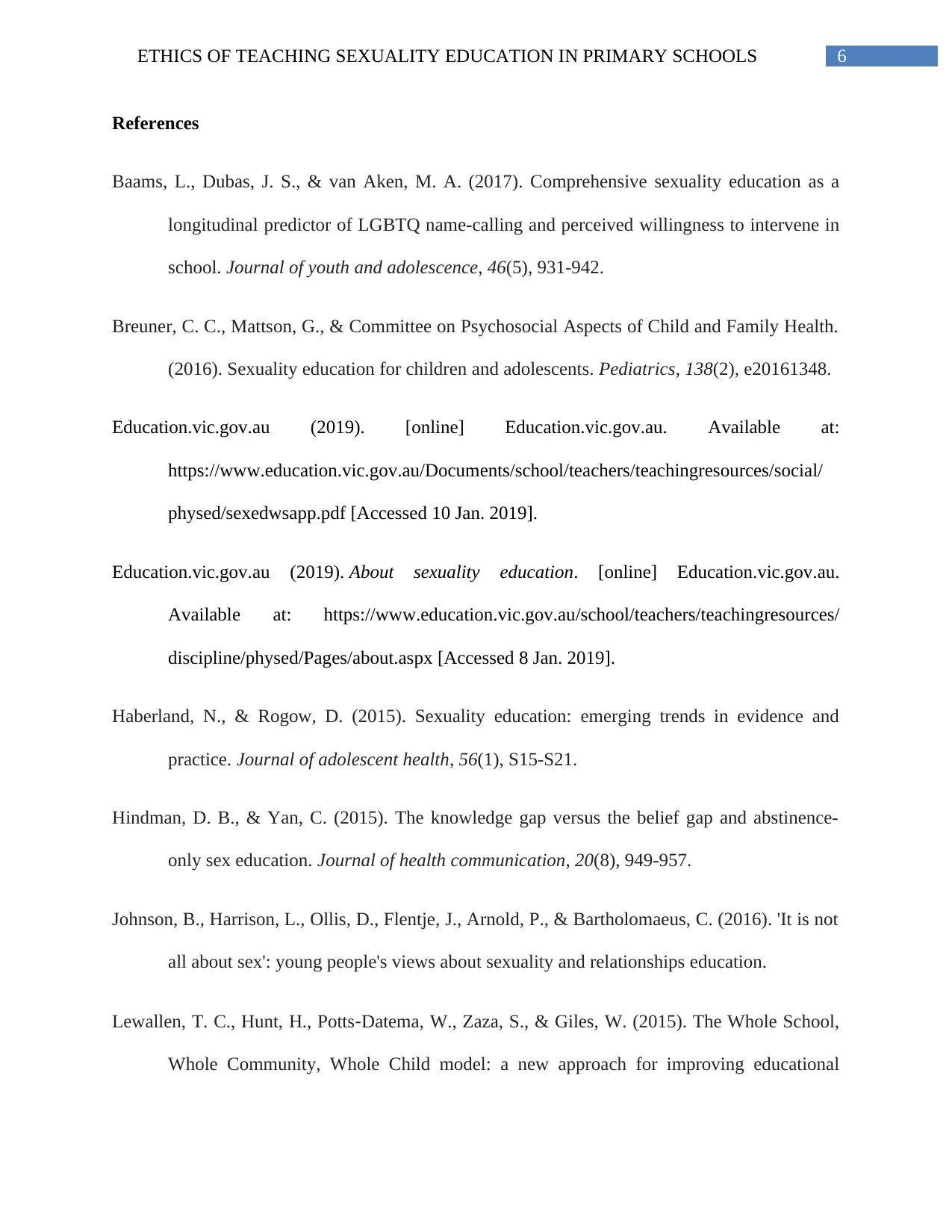
6ETHICS OF TEACHING SEXUALITY EDUCATION IN PRIMARY SCHOOLS
References
Baams, L., Dubas, J. S., & van Aken, M. A. (2017). Comprehensive sexuality education as a
longitudinal predictor of LGBTQ name-calling and perceived willingness to intervene in
school. Journal of youth and adolescence, 46(5), 931-942.
Breuner, C. C., Mattson, G., & Committee on Psychosocial Aspects of Child and Family Health.
(2016). Sexuality education for children and adolescents. Pediatrics, 138(2), e20161348.
Education.vic.gov.au (2019). [online] Education.vic.gov.au. Available at:
https://www.education.vic.gov.au/Documents/school/teachers/teachingresources/social/
physed/sexedwsapp.pdf [Accessed 10 Jan. 2019].
Education.vic.gov.au (2019). About sexuality education. [online] Education.vic.gov.au.
Available at: https://www.education.vic.gov.au/school/teachers/teachingresources/
discipline/physed/Pages/about.aspx [Accessed 8 Jan. 2019].
Haberland, N., & Rogow, D. (2015). Sexuality education: emerging trends in evidence and
practice. Journal of adolescent health, 56(1), S15-S21.
Hindman, D. B., & Yan, C. (2015). The knowledge gap versus the belief gap and abstinence-
only sex education. Journal of health communication, 20(8), 949-957.
Johnson, B., Harrison, L., Ollis, D., Flentje, J., Arnold, P., & Bartholomaeus, C. (2016). 'It is not
all about sex': young people's views about sexuality and relationships education.
Lewallen, T. C., Hunt, H., Potts‐Datema, W., Zaza, S., & Giles, W. (2015). The Whole School,
Whole Community, Whole Child model: a new approach for improving educational
References
Baams, L., Dubas, J. S., & van Aken, M. A. (2017). Comprehensive sexuality education as a
longitudinal predictor of LGBTQ name-calling and perceived willingness to intervene in
school. Journal of youth and adolescence, 46(5), 931-942.
Breuner, C. C., Mattson, G., & Committee on Psychosocial Aspects of Child and Family Health.
(2016). Sexuality education for children and adolescents. Pediatrics, 138(2), e20161348.
Education.vic.gov.au (2019). [online] Education.vic.gov.au. Available at:
https://www.education.vic.gov.au/Documents/school/teachers/teachingresources/social/
physed/sexedwsapp.pdf [Accessed 10 Jan. 2019].
Education.vic.gov.au (2019). About sexuality education. [online] Education.vic.gov.au.
Available at: https://www.education.vic.gov.au/school/teachers/teachingresources/
discipline/physed/Pages/about.aspx [Accessed 8 Jan. 2019].
Haberland, N., & Rogow, D. (2015). Sexuality education: emerging trends in evidence and
practice. Journal of adolescent health, 56(1), S15-S21.
Hindman, D. B., & Yan, C. (2015). The knowledge gap versus the belief gap and abstinence-
only sex education. Journal of health communication, 20(8), 949-957.
Johnson, B., Harrison, L., Ollis, D., Flentje, J., Arnold, P., & Bartholomaeus, C. (2016). 'It is not
all about sex': young people's views about sexuality and relationships education.
Lewallen, T. C., Hunt, H., Potts‐Datema, W., Zaza, S., & Giles, W. (2015). The Whole School,
Whole Community, Whole Child model: a new approach for improving educational
Paraphrase This Document
Need a fresh take? Get an instant paraphrase of this document with our AI Paraphraser
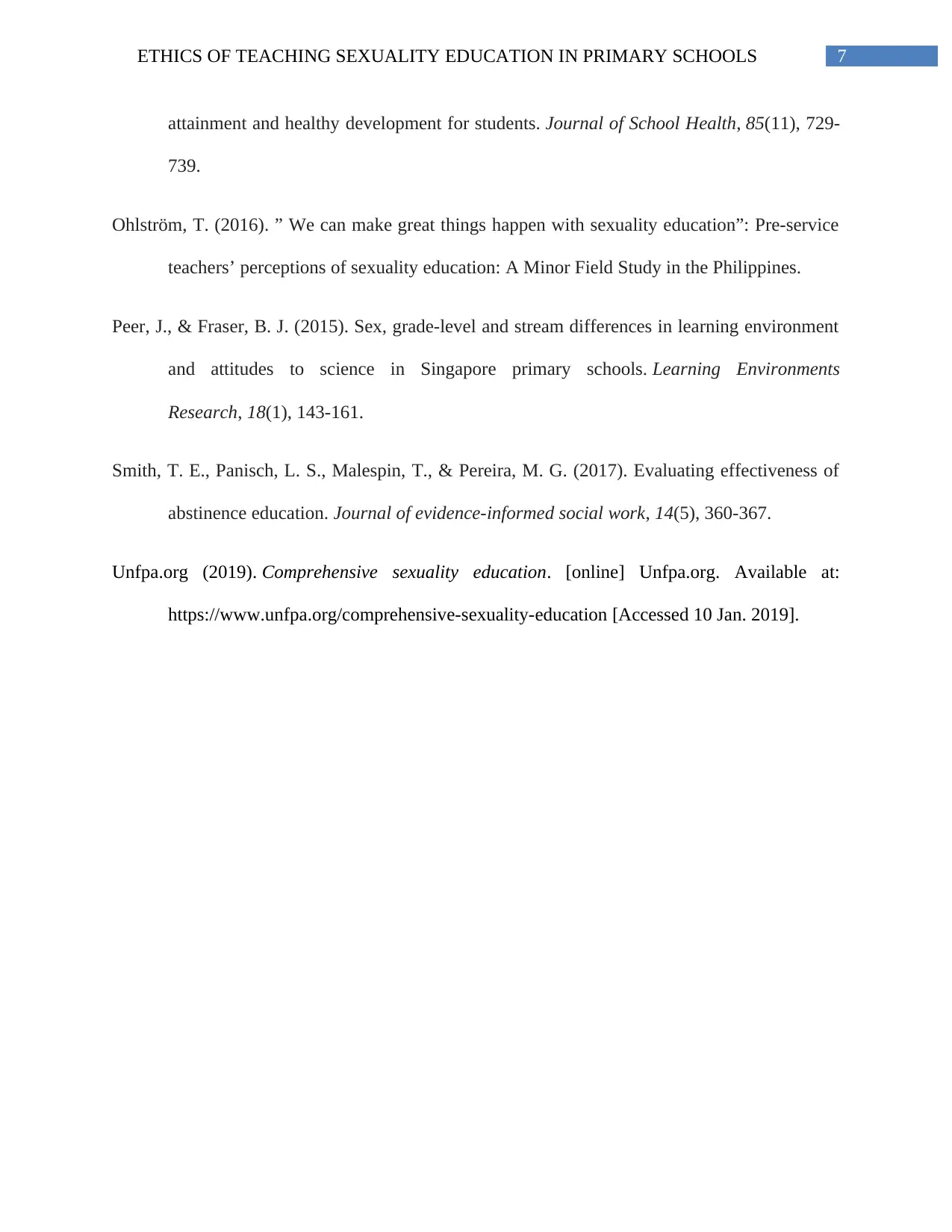
7ETHICS OF TEACHING SEXUALITY EDUCATION IN PRIMARY SCHOOLS
attainment and healthy development for students. Journal of School Health, 85(11), 729-
739.
Ohlström, T. (2016). ” We can make great things happen with sexuality education”: Pre-service
teachers’ perceptions of sexuality education: A Minor Field Study in the Philippines.
Peer, J., & Fraser, B. J. (2015). Sex, grade-level and stream differences in learning environment
and attitudes to science in Singapore primary schools. Learning Environments
Research, 18(1), 143-161.
Smith, T. E., Panisch, L. S., Malespin, T., & Pereira, M. G. (2017). Evaluating effectiveness of
abstinence education. Journal of evidence-informed social work, 14(5), 360-367.
Unfpa.org (2019). Comprehensive sexuality education. [online] Unfpa.org. Available at:
https://www.unfpa.org/comprehensive-sexuality-education [Accessed 10 Jan. 2019].
attainment and healthy development for students. Journal of School Health, 85(11), 729-
739.
Ohlström, T. (2016). ” We can make great things happen with sexuality education”: Pre-service
teachers’ perceptions of sexuality education: A Minor Field Study in the Philippines.
Peer, J., & Fraser, B. J. (2015). Sex, grade-level and stream differences in learning environment
and attitudes to science in Singapore primary schools. Learning Environments
Research, 18(1), 143-161.
Smith, T. E., Panisch, L. S., Malespin, T., & Pereira, M. G. (2017). Evaluating effectiveness of
abstinence education. Journal of evidence-informed social work, 14(5), 360-367.
Unfpa.org (2019). Comprehensive sexuality education. [online] Unfpa.org. Available at:
https://www.unfpa.org/comprehensive-sexuality-education [Accessed 10 Jan. 2019].
1 out of 8
Related Documents
Your All-in-One AI-Powered Toolkit for Academic Success.
+13062052269
info@desklib.com
Available 24*7 on WhatsApp / Email
![[object Object]](/_next/static/media/star-bottom.7253800d.svg)
Unlock your academic potential
Copyright © 2020–2025 A2Z Services. All Rights Reserved. Developed and managed by ZUCOL.





